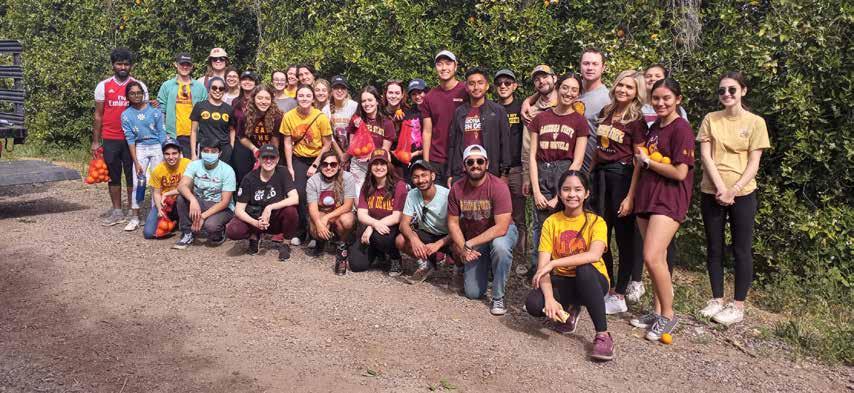
2 minute read
Collaborative action
Collaborative action involves multiple departments’ interdisciplinary efforts to advance ASU’s operational sustainability progress and integrate operational sustainability with its research, education and community missions. ASU embeds sustainability into departments’ daily activities through initiatives, personnel, programs, policies and procedures.
Successful examples of collaborative action include the following activities:
Campus activities
• 23 Sustainable Staff Event planners were trained in FY 2022, representing 18 ASU departments and offices.
• The ASU Fleet Electrification Task Force worked to transition the university’s fleet to zero-emission vehicles by purchasing four plug-in electric vehicles.
• Coca-Cola, Sodexo, Sun Devil Athletics, University Sustainability Practices and the Zero Waste department partnered to host two Green Games for football and volleyball. A total of 44,399 attendees were exposed to messaging about sustainability at ASU and efforts for Zero Waste games, including ticketless entry, the reusable cup program and compost and recycle bins in Sun Devil Stadium.
• Constructed 20 sustainability displays across all four campuses for October’s Campus Sustainability Month.
• Earth Month activities included six sustainability campus walking tours with 147 participants and 14 campus events with 960 participants. Events included a Garden Commons plants sale, Fair Trade tabling in residence halls, office compost rollout and various Green Games.
• Hosted five U.S. Green Building Council workshops to 197 staff and students providing information on Leadership in Energy and Environmental Design certification to the campus community.
• Installed 13 electric vehicle charging ports. There are 110 charging ports available across ASU’s four campuses in metropolitan Phoenix.
• The ASU Starbucks Center, several student groups and departments collaborated to reduce single-use cups on campus, saving over 21,000 cups from use.
Community efforts
Volunteers donated 5,000 pounds of harvested oranges to local food banks
• ASU partnered with Arizona Public Service, Salt River Project, Tucson Electric Power, Southwest Gas, the University of Arizona and Northern Arizona University to form a new interdisciplinary coalition to attain a carbon-neutral economy in Arizona. The ASU-based Center for an Arizona Carbon-Neutral Economy is housed within the Julie Ann Wrigley Global Futures Laboratory on the Tempe campus.
• The Rio Reimagined Initiative hosted an Earth Day clean-up along the Salt River. Over 100 volunteers removed 10 tons of trash from the riverbed. The event united ASU’s University City Exchange, students and alums, employees from the city of Phoenix’s Tres Rios wetlands and the Arizona Department of Environmental Quality.
ASU paper use in recycled content
Peter Schlosser
Community success
According to the ASU Charter, ASU assumes fundamental responsibility for the economic, social, cultural and overall health of the communities it serves. Community success examples include:
• During FY 2022, ASU’s total spending of $1.73 billion included 15.41% toward federally recognized small businesses. The university also spent 5.02% with diverse businesses.
• The ASU Project Cities program partnered with the city of Peoria to identify residents who often do not receive messages about critical activities and design strategies to reach them. Three classes supported this work: JUS 456 Human Rights and Sustainability, JUS 500 Research Methods and JUS 301 Research Methods.
• ASU welcomed 61 Afghan refugee women to Arizona so they could complete their education. ASU has committed to funding each one in completing their degree, including room and board, textbooks, class materials and required supplies.
• The Advisory Council on African American Affairs at ASU released The LIFT Report: Status of Black and African Americans at Arizona State University. The fall 2021 LIFT Report outlines the progress and developments being made to find solutions to issues of bias, discrimination and underrepresentation at ASU and to further transform the community into a welcoming environment for educators and learners.
• The U.S. Department of Education named ASU a Hispanic-Serving Institution, a significant milestone in its enterprise-wide commitment to increase the diversity of its student body.
• ASU’s in-state student population demographics continue to reflect the economic diversity of Arizona’s population.








